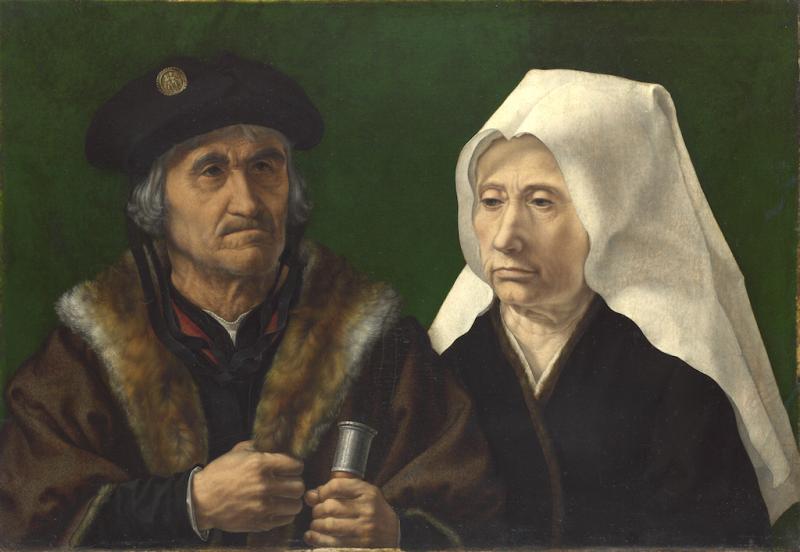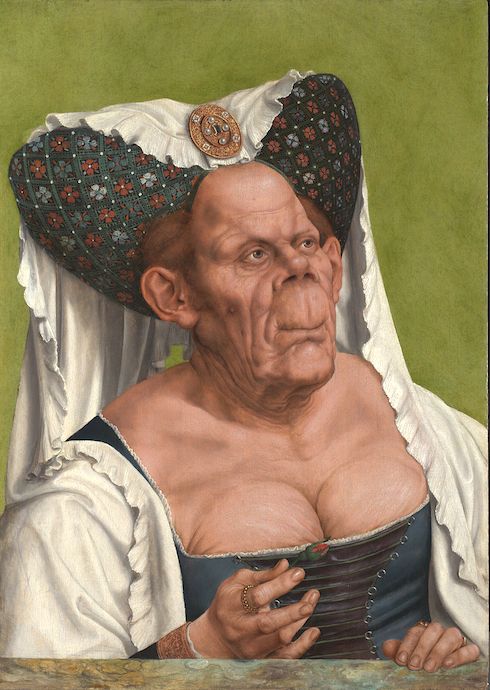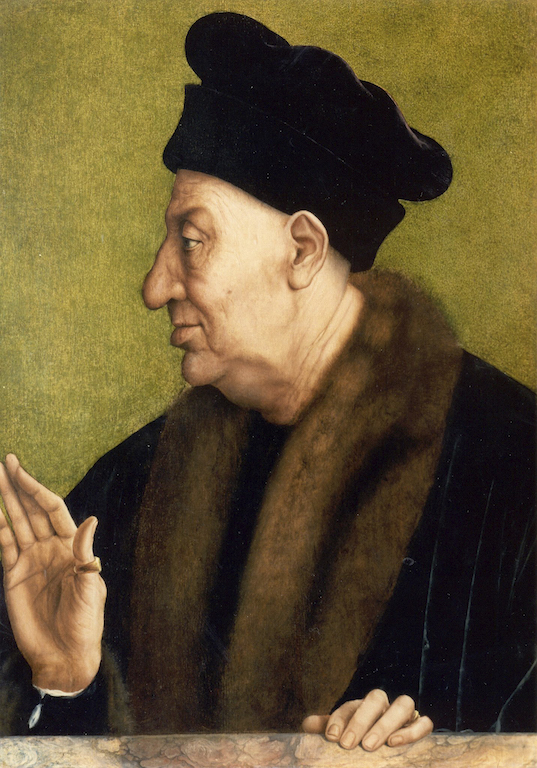The Ugly Duchess: Beauty and Satire in the Renaissance, National Gallery review - put in context, a much-loved picture reveals its complexity | reviews, news & interviews
The Ugly Duchess: Beauty and Satire in the Renaissance, National Gallery review - put in context, a much-loved picture reveals its complexity
The Ugly Duchess: Beauty and Satire in the Renaissance, National Gallery review - put in context, a much-loved picture reveals its complexity
An aged, would-be seductress is reunited with her reluctant partner

Despite the fact that it’s a cruel depiction of an aging woman, I have always loved Quinten Massys’ The Ugly Duchess (pictured below, left). The Flemish artist invites us to laugh at an old dear who, in the hope of attracting a suitor, has tucked her hair into a horned headdress and decked herself in a décolleté gown that exposes her wrinkled cleavage.
Even in 1513, her ridiculous outfit would have been outmoded. In her hand she holds a rosebud, suggestive of amorous intent; the implication is that this misguided soul has donned her youthful finery in an attempt to regain her lost allure and capture the attention of an admirer.
Ironically, the paint surface across her bosom is covered with a fine mesh of tiny cracks. In a poignant reminder that nothing escapes the ravages of time, the pigment that describes her withered skin has also dried out over the centuries.
 The National Gallery has reunited the painting with its companion piece, a picture of an elderly man also dressed in outdated attire (pictured below, right). His portrayal is far more sympathetic than hers; he wears a floppy velvet hat whose curves echo his big nose and knobbly jowls, but the joke is understated. Massys resists the temptation to play him for laughs as he does the old woman. Casting a jaded eye towards his would-be seductress, the man holds up his hand, as if to say “Thank you, but no thank you.”
The National Gallery has reunited the painting with its companion piece, a picture of an elderly man also dressed in outdated attire (pictured below, right). His portrayal is far more sympathetic than hers; he wears a floppy velvet hat whose curves echo his big nose and knobbly jowls, but the joke is understated. Massys resists the temptation to play him for laughs as he does the old woman. Casting a jaded eye towards his would-be seductress, the man holds up his hand, as if to say “Thank you, but no thank you.”
By comparison with the Duchess, he is unremarkable – elderly and dull. So what is it that makes her so endlessly fascinating? Her extraordinary features are all awry; her big ears, snub nose, unusually long upper lip, heavy jaw and turkey neck verge on deformity, yet her brown eyes seem filled with hope and longing. When compared with the woman in Jan Gossaert’s portrait of An Elderly Couple 1520 (main picture), also on show, it becomes clear just how far she deviates from the norm and how brazen her character must have seemed at the time.
The woman in Gossaert’s painting stands behind and to the left of her husband, in the subordinate position reserved for wives. Plainly dressed, she gazes modestly downwards. With his resolute expression and clenched fists, her husband seems poised for action, while everything about her suggests passivity and resignation. Her expectations seem low and, consequently, her face lacks vitality. By contrast, Massys puts his woman in the man’s place and, with her raised eyes and active pose, gives her the initiative; instead of standing placidly by, she instigates a social encounter.
 This could be a factor in why, despite her prominent breasts, I’ve always thought she resembled a man in drag. And according to the display, there may be some truth in my assumption. Massys based his Duchess on the copy of a drawing, which is now lost, by Leonardo da Vinci of an old woman with similarly bizarre features and clothing. But another source of inspiration was probably the "Sausage Woman", a character to be seen cavorting through the streets of Europe during carnival surrounded by Morris dancers. Suggestively waving a pig’s trotter and carrying a string of sausages impaled on a barbecue stick, this matron would have been played by a man in drag and wearing a horned headdress indicative of lascivious ambitions.
This could be a factor in why, despite her prominent breasts, I’ve always thought she resembled a man in drag. And according to the display, there may be some truth in my assumption. Massys based his Duchess on the copy of a drawing, which is now lost, by Leonardo da Vinci of an old woman with similarly bizarre features and clothing. But another source of inspiration was probably the "Sausage Woman", a character to be seen cavorting through the streets of Europe during carnival surrounded by Morris dancers. Suggestively waving a pig’s trotter and carrying a string of sausages impaled on a barbecue stick, this matron would have been played by a man in drag and wearing a horned headdress indicative of lascivious ambitions.
One source of the painting’s enduring fascination, then, is the ambiguity of a main character whose meaning may be more complex than at first supposed. What makes the picture so poignant for me, though, is the old woman’s optimism. She has yet to discover just how misguided are her attempts at seduction, since she hasn’t grasped the fact (as true now as it was then) that most old men want partners half their age and often succeed in getting them. Because of a discrepancy she hasn’t understood, she is a laughing stock. Plus ça change.
- The Ugly Duchess: Beauty and Satire in the Renaissance at the National Gallery until 11 June
- More visual arts reviews on theartsdesk
rating
Explore topics
Share this article
The future of Arts Journalism
You can stop theartsdesk.com closing!
We urgently need financing to survive. Our fundraising drive has thus far raised £49,000 but we need to reach £100,000 or we will be forced to close. Please contribute here: https://gofund.me/c3f6033d
And if you can forward this information to anyone who might assist, we’d be grateful.

Subscribe to theartsdesk.com
Thank you for continuing to read our work on theartsdesk.com. For unlimited access to every article in its entirety, including our archive of more than 15,000 pieces, we're asking for £5 per month or £40 per year. We feel it's a very good deal, and hope you do too.
To take a subscription now simply click here.
And if you're looking for that extra gift for a friend or family member, why not treat them to a theartsdesk.com gift subscription?
more Visual arts
 'We are bowled over!' Thank you for your messages of love and support
Much-appreciated words of commendation from readers and the cultural community
'We are bowled over!' Thank you for your messages of love and support
Much-appreciated words of commendation from readers and the cultural community
 Folkestone Triennial 2025 - landscape, seascape, art lovers' escape
Locally rooted festival brings home many but not all global concerns
Folkestone Triennial 2025 - landscape, seascape, art lovers' escape
Locally rooted festival brings home many but not all global concerns
 Sir Brian Clarke (1953-2025) - a personal tribute
Remembering an artist with a gift for the transcendent
Sir Brian Clarke (1953-2025) - a personal tribute
Remembering an artist with a gift for the transcendent
 Emily Kam Kngwarray, Tate Modern review - glimpses of another world
Pictures that are an affirmation of belonging
Emily Kam Kngwarray, Tate Modern review - glimpses of another world
Pictures that are an affirmation of belonging
 Kiefer / Van Gogh, Royal Academy review - a pairing of opposites
Small scale intensity meets large scale melodrama
Kiefer / Van Gogh, Royal Academy review - a pairing of opposites
Small scale intensity meets large scale melodrama
 Jenny Saville: The Anatomy of Painting, National Portrait Gallery review - a protégé losing her way
A brilliant painter in search of a worthwhile subject
Jenny Saville: The Anatomy of Painting, National Portrait Gallery review - a protégé losing her way
A brilliant painter in search of a worthwhile subject
 Abstract Erotic, Courtauld Gallery review - sculpture that is sensuous, funny and subversive
Testing the boundaries of good taste, and winning
Abstract Erotic, Courtauld Gallery review - sculpture that is sensuous, funny and subversive
Testing the boundaries of good taste, and winning
 Edward Burra, Tate Britain review - watercolour made mainstream
Social satire with a nasty bite
Edward Burra, Tate Britain review - watercolour made mainstream
Social satire with a nasty bite
 Ithell Colquhoun, Tate Britain review - revelations of a weird and wonderful world
Emanations from the unconscious
Ithell Colquhoun, Tate Britain review - revelations of a weird and wonderful world
Emanations from the unconscious
 Rachel Jones: Gated Canyons, Dulwich Picture Gallery review - teeth with a real bite
Mouths have never looked so good
Rachel Jones: Gated Canyons, Dulwich Picture Gallery review - teeth with a real bite
Mouths have never looked so good
 Yoshitomo Nara, Hayward Gallery review - sickeningly cute kids
How to make millions out of kitsch
Yoshitomo Nara, Hayward Gallery review - sickeningly cute kids
How to make millions out of kitsch
 Hamad Butt: Apprehensions, Whitechapel Gallery review - cool, calm and potentially lethal
The YBA who didn’t have time to become a household name
Hamad Butt: Apprehensions, Whitechapel Gallery review - cool, calm and potentially lethal
The YBA who didn’t have time to become a household name

Add comment